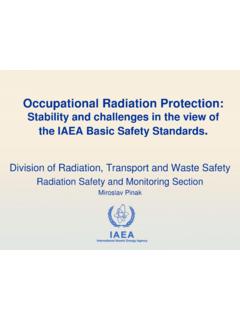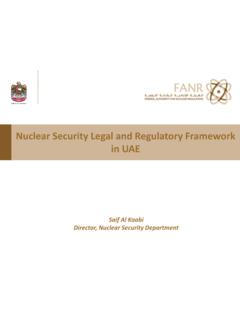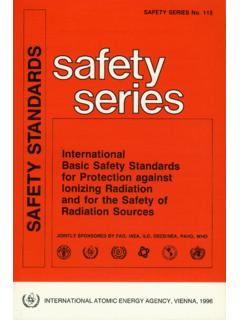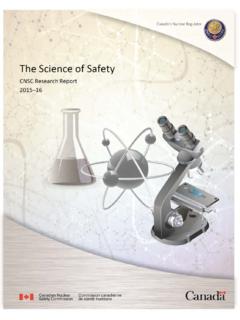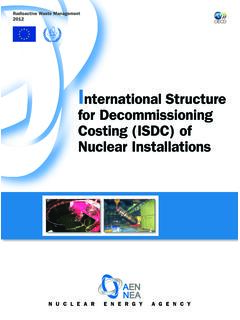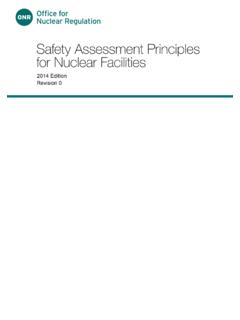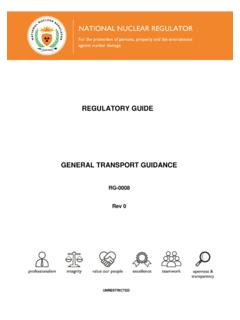Transcription of 1986-2016: CHERNOBYL at 30 An update - WHO
1 1 25 April 2016 1986- 2016 : CHERNOBYL at 30 An update On 26 April 1986, an explosion and fires at the CHERNOBYL nuclear plant in Ukraine caused the largest uncontrolled radioactive release in the history of the civil nuclear industry. Large quantities of radioactive iodine and cesium were released into the air due to the explosion and fire at the accident site. Most of this radioactive material was deposited near the installation, but a substantial amount of these radionuclides was carried by wind currents over Belarus, the Russian Federation and Ukraine and, to some extent, over parts of Europe. In 2006, WHO published a report Heath Effects of the CHERNOBYL Accident and Special Health Care Programmes 1 summarizing 20 years of research on the health consequences of the CHERNOBYL accident. 1. Updated assessments of health effects of the CHERNOBYL accident since 2006 In 2011, the United Nations Scientific Committee on the Effects of Atomic Radiation (UNSCEAR) published a report "Health effects due to radiation from the CHERNOBYL accident".
2 The findings were based on more than two decades of experimental and analytical studies of the radiation consequences of the CHERNOBYL accident on the health of the exposed populations. The report is the most comprehensive evaluation to date of human exposure levels and health effects from the CHERNOBYL accident2 . Thyroid cancer For the last three decades, attention has focused on investigating the association between exposure to radionuclides released in the CHERNOBYL accident and late effects, in particular thyroid cancer. Doses to the thyroid received in the first few months after the accident were particularly high in those children and adolescents living in the most affected regions, who drank milk contaminated with radioactive iodine. This subpopulation has since been followed-up through national CHERNOBYL registries for increased risk of thyroid cancer3.
3 The 2006 WHO report anticipated that thyroid cancer incidence due to the CHERNOBYL accident would continue to increase over time. According to national studies in the three affected countries, more than 11,000 thyroid cancer cases had been diagnosed in this group by 2016 . It is most likely that a fraction of these thyroid cancers is attributable to radioiodine intake in 1986, although long-term increases are difficult to quantify, for the study population is aging and their spontaneous thyroid cancer risk is also increasing. Other cancers Previously reported increase in the incidence of solid cancers and leukaemia due to radiation from the CHERNOBYL accident in the exposed populations continues to be investigated. In particular, a CHERNOBYL cohort of 530,000 1 Report of the UN CHERNOBYL Forum Expert Group Health , WHO, Geneva, 2006 is available at: 2 UNSCEAR CHERNOBYL report (2011).
4 URL: 3 Bogdanova T. et al. Histopathological features of papillary thyroid carcinomas detected during four screening examinations of a Ukrainian-American cohort. Br J Cancer. 2015 Dec 1; 113(11):1556-64. URL: 2 registered recovery and clean-up operation workers, who received doses ranging from 20 to 500 millisievert (mSv) in 1986-1990, is being closely followed up for potential risk of cancer and other diseases4. Three WHO Collaborating Centers in the Russian Federation and Ukraine are leading long-term follow-up programmes on CHERNOBYL -affected populations in cooperation with WHO. There is emerging evidence from other studies (workers in the nuclear industry and medically exposed populations) that low dose protracted exposures to ionizing radiation increase the relative risk of cancer. Such risk increase can only be validated through large, well-designed epidemiological studies of populations with well-characterized exposures from the CHERNOBYL accident.
5 It should be noted that a general increase in cancer incidence has been reported in recent decades worldwide, which must be also taken into account when interpreting the results of the CHERNOBYL studies. Non-cancer diseases Since the publication of the WHO 2006 report, new evidence has emerged on radiation induced cataracts in clean-up workers who were externally exposed to radiation in the course of their work in CHERNOBYL . Until recently, it was considered that the risk of cataract increases at doses above 150 mSv, based on earlier data derived from other studies on non- CHERNOBYL populations, radiation technologists and astronauts. Recent international reports show that doses of radiation as low as 20 mSv may cause an increased risk of developing a radiation-induced cataract of the eye lens5,6,7. The data obtained in the Ukrainian-American CHERNOBYL Ocular Study resulted in a revision down to 20 mSv of ICRP recommendations for occupational dose limit for the lens of the eye8.
6 In the WHO report on CHERNOBYL (2006), experts noted an indication of potentially increased risk of cardiovascular diseases (CVDs) among clean-up workers and suggested further studies on this effect. Recently, the risk of CVDs due to ionizing radiation exposure at low doses was reported in a meta-analysis study that demonstrated increased cardiovascular mortality in cohorts of persons exposed to ionizing radiation, including Ukrainian clean-up workers9. One should however keep in mind that many other factors contribute to the increased risk of CVDs , such as smoking, diet, physical activity, stress, general health, age and genetics. Psycho-social impact and mental health The psycho-social impact of disasters and emergencies has been well documented. It has been reported to be the CHERNOBYL accident s main public health impact that affected the largest number of people.
7 A similar effect is now reported in the aftermath of the Fukushima disaster, that caused evacuation and relocation of large group of people, who lost their homes, jobs, were placed in temporary housing in shelters and did not have an adequate access to health care. Several international studies reported that CHERNOBYL -affected populations had anxiety levels that were twice as high than non-exposed population, and were more likely to report multiple unexplained physical symptoms and subjective poor health. To some extent, these symptoms were driven by the belief that their health was adversely affected by the disaster and the fact that they were diagnosed by a physician with a CHERNOBYL -related health 4 Kashcheev V. et al. Incidence and mortality of solid cancer among emergency workers of the CHERNOBYL accident: assessment of radiation risks for the follow-up period of 1992 2009.
8 Radiation and Environmental Biophysics. March 2015, Volume 54, Issue 1, pp 13-23. URL: 5 V. V. Chumak, et al., Dosimetry for a study of low-dose radiation cataracts among CHERNOBYL clean-up workers. Radiat. Res. 167, 606 614 (2007). URL: 6 R., Shore et al. Epidemiological studies of cataract risk at low to moderate radiation doses: (not) seeing is believing. Radiat Res. 2010 Dec;174(6):889-94. 1. Epub 2010 Aug 30. URL: 7 Hammer G. et al. Occupational exposure to low doses of ionizing radiation and cataract development: a systematic literature review and perspectives on future studies. Radiat Environ Biophys. 2013 Aug;52(3):303-19. URL: 8 ICRP statement on Tissue Reactions: 9 Little M. et al. Systematic Review and Meta-analysis of Circulatory Disease from Exposure to Low-Level Ionizing Radiation and Estimates of Potential Population Mortality Risks. Environ Health Perspect. 2012 Nov; 120(11): 1503 URL: 3 problem.
9 Given that rates of mental health problems increase after a disaster and may manifest years after the event, it is important to provide access to mental health services in disaster-affected areas on a long-term basis. It is also extremely important to provide adequate information to the affected populations and to provide them with psychological support through special programmes. Several international projects aimed at developing such infrastructure, providing training materials and facilitating training programs for the various target groups in the affected regions of Belarus, Ukraine and Russia: primary health care workers, teachers, media workers, and local decision makers. In addition, the implementation of long-term health surveillance programmes, which continue for 30 years, may also leave a certain psychological impact. The cost-efficiency of such programmes, their ethical implications and clinical justification should be evaluated.
10 CHERNOBYL s wealth of experience provides a unique opportunity to study the efficacy of such programmes. 2. UN Action Plan for the Third Decade of CHERNOBYL and ICRIN project In 2007, the UN General Assembly adopted a Resolution on CHERNOBYL and announced the launch of the UN Action Plan for the Third Decade of CHERNOBYL with the key priorities set on sustainable development of CHERNOBYL -affected areas and return to normality. Between 2009 and 2013, as part of the UN Action Plan implementation, WHO contributed to the inter-agency International CHERNOBYL Research and Information Network (ICRIN) project10. The joint UNDP, IAEA, WHO and UNICEF project aimed to alleviate the stigma of psychological impact in society, encourage self-reliance, and empower local communities to take control over their own lives. One of the ways to achieve these goals is to promote healthy life styles, including physical activity and healthy diet, and to put the radiation risk in the context of environmental, behavioural, and other risk factors for various non-communicable diseases, including cancer.










